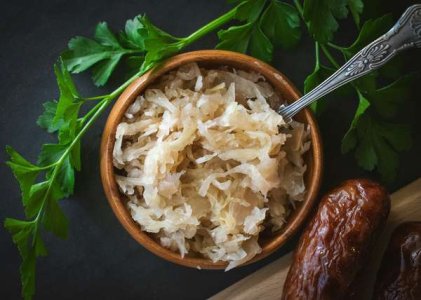Doctors are raving about this ancient condiment—Discover the 27-calorie secret with “insane” health benefits
- Replies 0
Disclaimer: The information provided in this article is for educational purposes only and is not intended as a substitute for professional medical advice, diagnosis, or treatment. Always consult your physician or other qualified healthcare providers with any questions you may have regarding a medical condition or before making any changes to your health regimen.
If you’ve ever wandered through a deli or peeked into your grandmother’s fridge, chances are you’ve encountered a humble, tangy pile of sauerkraut.
But did you know that this ancient, 27-calorie-per-serving condiment is now being hailed by doctors and scientists alike as a gut-health powerhouse?
That’s right—sauerkraut, the unassuming shredded cabbage that’s been a staple on dinner tables for centuries, is having a well-deserved moment in the nutritional spotlight.
Let’s dig into why this old-world favorite is suddenly the darling of modern medicine, and how you can harness its “insane” health benefits—without spending a fortune on trendy supplements or complicated cleanses.
The Science Behind the Crunch: Why Sauerkraut Works Wonders
At its core, sauerkraut is simply cabbage and salt, left to ferment thanks to the magic of lactic acid bacteria. This process not only gives sauerkraut its signature tang and long shelf life, but also transforms it into a nutritional goldmine.
According to Dr. Steven Gundry, a renowned physician and best-selling author, sauerkraut’s fermentation unlocks a treasure trove of health-boosting compounds—most notably, postbiotics.

You’ve probably heard of probiotics (the “good” bacteria in yogurt and supplements) and prebiotics (the fiber that feeds those bacteria).
But postbiotics? These are the beneficial byproducts created when those live bacteria break down the sugars in cabbage during fermentation. Think of them as the 'secret sauce' that helps your gut thrive.
Postbiotics, working hand-in-hand with the prebiotic fiber in cabbage, help diversify your gut microbiome.
Why does that matter? A diverse gut microbiome is linked to smoother digestion, better nutrient absorption, a stronger immune system, and even improved mood and brain health. In other words, a happy gut can mean a happier, healthier you.
Also read: A simple yogurt add-in could do wonders for your gut—here’s what to know
Sauerkraut vs. Raw Cabbage: The Fermentation Advantage
You might be wondering: “Can’t I just eat raw cabbage and get the same benefits?” Not quite.
A recent study from the University of California, Davis, found that sauerkraut actually outperformed raw cabbage in protecting intestinal cells from inflammation-related damage. This is a big deal for anyone dealing with digestive issues like inflammatory bowel disease, or simply looking to keep their gut in tip-top shape.
Dr. Maria Marco, a professor of food science and technology and lead author of the study, explains: “Even a regular serving of sauerkraut can help us in the long run against inflammation and make our digestive tract more resilient when we have a disturbance.”
Fermentation: Nature’s Detox
Here’s another fascinating tidbit: Many plants, including cabbage, naturally contain compounds like lectins and oxalates that can be tough on our digestive systems.

But during fermentation, the bacteria “eat up” many of these plant defense compounds, making sauerkraut easier to digest than its raw counterpart. It’s like nature’s own detox, no expensive juice cleanse required!
Flavor Boosters with Extra Benefits
Traditional sauerkraut is delicious on its own, but many recipes include garlic and scallions for an extra kick.
According to Dr. Gundry, these additions aren’t just for flavor—they bring their own health perks. Garlic and scallions contain allicin, a compound that helps repair the lining of your blood vessels and even supports your blood-brain barrier. So, every forkful is doing double (or triple!) duty for your health.
How to Add Sauerkraut to Your Diet—The Right Way
Ready to give your gut a boost? Dr. Gundry says you could start seeing benefits in as little as 30 days. Studies show that people who regularly eat fermented foods like sauerkraut experience remarkable improvements in inflammation and gut biodiversity.
Also read: New year, new eats: Scientists reveal the must-try food trends of 2025
But before you dive headfirst into the kraut jar, a word of caution: If you’re new to fermented foods or high-fiber diets, start slow.
Your gut bacteria love fiber, and they’ll let you know by producing extra gas and bloating at first. Begin with a small spoonful daily and gradually work up to a full serving (about half a cup). Your digestive system will thank you for the gentle introduction.
Shopping Tips: Not All Sauerkraut Is Created Equal
When you’re at the grocery store, keep an eye out for added sugars—many commercial brands sweeten their sauerkraut to appeal to American palates.
If you’re looking for a healthier option, choose raw, unpasteurized sauerkraut from the refrigerated section. These versions are teeming with live cultures and haven’t been heat-treated, so you get the full spectrum of probiotic and postbiotic benefits.
Source: Dr. Eric Berg DC / Youtube.
If you find the flavor a bit too bold, Dr. Gundry suggests adding a sprinkle of allulose, a no-calorie sweetener that also acts as a prebiotic. It’s a win-win for your taste buds and your gut.
Consistency Is Key
Like most things in life, the real magic happens with consistency.
Research shows that the benefits of probiotic and postbiotic foods are greatest when they’re a regular part of your diet. So, whether you enjoy sauerkraut as a side, on a sandwich, or straight from the jar (no judgment here!), make it a habit.
Beyond the Gut: Other Surprising Benefits of Sauerkraut
While gut health is the star of the show, sauerkraut’s benefits don’t stop there. Some studies suggest that regular consumption may help:
- Support heart health by lowering cholesterol and blood pressure
- Strengthen bones thanks to its vitamin K content
- Boost immunity with its rich supply of vitamin C and antioxidants
- Aid in weight management, since it’s low in calories but high in fiber, helping you feel full longer
Read next: Exposed: The truth about these 10 healthy foods that are gutting your gut health without your knowledge

Are you a sauerkraut superfan, or is this your first foray into fermented foods? Have you noticed any changes in your health since adding kraut to your plate? Do you have a favorite way to enjoy it—on a hot dog, in a salad, or straight from the jar? Share your stories, tips, and questions in the comments below!
If you’ve ever wandered through a deli or peeked into your grandmother’s fridge, chances are you’ve encountered a humble, tangy pile of sauerkraut.
But did you know that this ancient, 27-calorie-per-serving condiment is now being hailed by doctors and scientists alike as a gut-health powerhouse?
That’s right—sauerkraut, the unassuming shredded cabbage that’s been a staple on dinner tables for centuries, is having a well-deserved moment in the nutritional spotlight.
Let’s dig into why this old-world favorite is suddenly the darling of modern medicine, and how you can harness its “insane” health benefits—without spending a fortune on trendy supplements or complicated cleanses.
The Science Behind the Crunch: Why Sauerkraut Works Wonders
At its core, sauerkraut is simply cabbage and salt, left to ferment thanks to the magic of lactic acid bacteria. This process not only gives sauerkraut its signature tang and long shelf life, but also transforms it into a nutritional goldmine.
According to Dr. Steven Gundry, a renowned physician and best-selling author, sauerkraut’s fermentation unlocks a treasure trove of health-boosting compounds—most notably, postbiotics.

Sauerkraut is a low-calorie (27 calories per serve), fermented cabbage condiment that offers powerful gut health benefits due to its postbiotics and prebiotic fiber. Image source: Kelsey Todd / Unsplash.
You’ve probably heard of probiotics (the “good” bacteria in yogurt and supplements) and prebiotics (the fiber that feeds those bacteria).
But postbiotics? These are the beneficial byproducts created when those live bacteria break down the sugars in cabbage during fermentation. Think of them as the 'secret sauce' that helps your gut thrive.
Postbiotics, working hand-in-hand with the prebiotic fiber in cabbage, help diversify your gut microbiome.
Why does that matter? A diverse gut microbiome is linked to smoother digestion, better nutrient absorption, a stronger immune system, and even improved mood and brain health. In other words, a happy gut can mean a happier, healthier you.
Also read: A simple yogurt add-in could do wonders for your gut—here’s what to know
Sauerkraut vs. Raw Cabbage: The Fermentation Advantage
You might be wondering: “Can’t I just eat raw cabbage and get the same benefits?” Not quite.
A recent study from the University of California, Davis, found that sauerkraut actually outperformed raw cabbage in protecting intestinal cells from inflammation-related damage. This is a big deal for anyone dealing with digestive issues like inflammatory bowel disease, or simply looking to keep their gut in tip-top shape.
Dr. Maria Marco, a professor of food science and technology and lead author of the study, explains: “Even a regular serving of sauerkraut can help us in the long run against inflammation and make our digestive tract more resilient when we have a disturbance.”
Fermentation: Nature’s Detox
Here’s another fascinating tidbit: Many plants, including cabbage, naturally contain compounds like lectins and oxalates that can be tough on our digestive systems.

Scientific research shows eating sauerkraut can reduce inflammation in the gut and protect against digestive issues better than raw cabbage. Image source: Jonathan Pielmayer / Unsplash.
But during fermentation, the bacteria “eat up” many of these plant defense compounds, making sauerkraut easier to digest than its raw counterpart. It’s like nature’s own detox, no expensive juice cleanse required!
Flavor Boosters with Extra Benefits
Traditional sauerkraut is delicious on its own, but many recipes include garlic and scallions for an extra kick.
According to Dr. Gundry, these additions aren’t just for flavor—they bring their own health perks. Garlic and scallions contain allicin, a compound that helps repair the lining of your blood vessels and even supports your blood-brain barrier. So, every forkful is doing double (or triple!) duty for your health.
How to Add Sauerkraut to Your Diet—The Right Way
Ready to give your gut a boost? Dr. Gundry says you could start seeing benefits in as little as 30 days. Studies show that people who regularly eat fermented foods like sauerkraut experience remarkable improvements in inflammation and gut biodiversity.
Also read: New year, new eats: Scientists reveal the must-try food trends of 2025
But before you dive headfirst into the kraut jar, a word of caution: If you’re new to fermented foods or high-fiber diets, start slow.
Your gut bacteria love fiber, and they’ll let you know by producing extra gas and bloating at first. Begin with a small spoonful daily and gradually work up to a full serving (about half a cup). Your digestive system will thank you for the gentle introduction.
Shopping Tips: Not All Sauerkraut Is Created Equal
When you’re at the grocery store, keep an eye out for added sugars—many commercial brands sweeten their sauerkraut to appeal to American palates.
If you’re looking for a healthier option, choose raw, unpasteurized sauerkraut from the refrigerated section. These versions are teeming with live cultures and haven’t been heat-treated, so you get the full spectrum of probiotic and postbiotic benefits.
Source: Dr. Eric Berg DC / Youtube.
If you find the flavor a bit too bold, Dr. Gundry suggests adding a sprinkle of allulose, a no-calorie sweetener that also acts as a prebiotic. It’s a win-win for your taste buds and your gut.
Consistency Is Key
Like most things in life, the real magic happens with consistency.
Research shows that the benefits of probiotic and postbiotic foods are greatest when they’re a regular part of your diet. So, whether you enjoy sauerkraut as a side, on a sandwich, or straight from the jar (no judgment here!), make it a habit.
Beyond the Gut: Other Surprising Benefits of Sauerkraut
While gut health is the star of the show, sauerkraut’s benefits don’t stop there. Some studies suggest that regular consumption may help:
- Support heart health by lowering cholesterol and blood pressure
- Strengthen bones thanks to its vitamin K content
- Boost immunity with its rich supply of vitamin C and antioxidants
- Aid in weight management, since it’s low in calories but high in fiber, helping you feel full longer
Read next: Exposed: The truth about these 10 healthy foods that are gutting your gut health without your knowledge
Key Takeaways
- Sauerkraut is a low-calorie (27 calories per serve), fermented cabbage condiment that offers powerful gut health benefits due to its postbiotics and prebiotic fiber.
- Scientific research shows eating sauerkraut can reduce inflammation in the gut and protect against digestive issues better than raw cabbage.
- Introducing sauerkraut to your diet gradually can improve your gut microbiome, digestion and inflammation markers within 30 days, but you should start with small amounts to avoid bloating and discomfort.
- Opt for sauerkraut with minimal added sugar, and for extra health kicks, add garlic or scallions for their vessel-repairing compounds; regular consumption is the key to maximum benefits.
Are you a sauerkraut superfan, or is this your first foray into fermented foods? Have you noticed any changes in your health since adding kraut to your plate? Do you have a favorite way to enjoy it—on a hot dog, in a salad, or straight from the jar? Share your stories, tips, and questions in the comments below!






